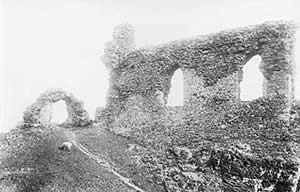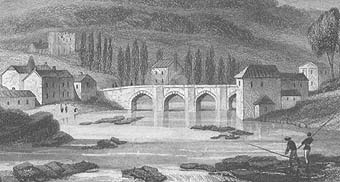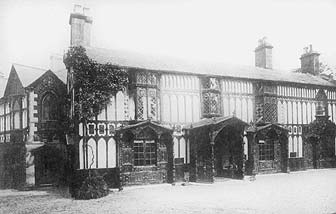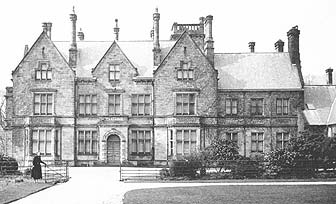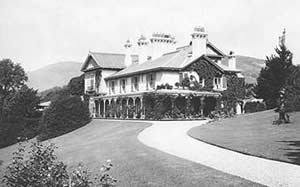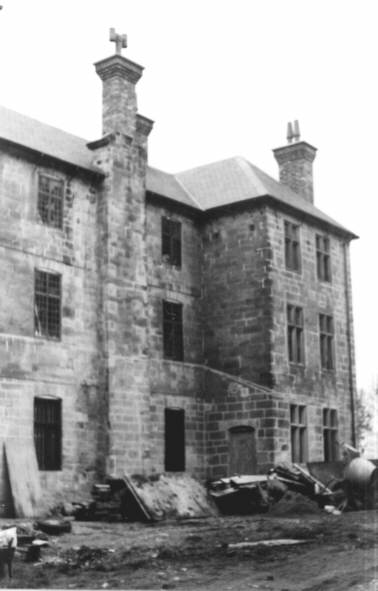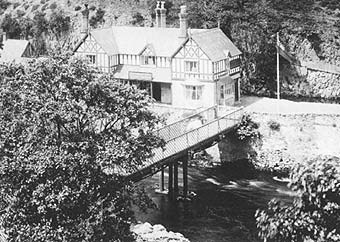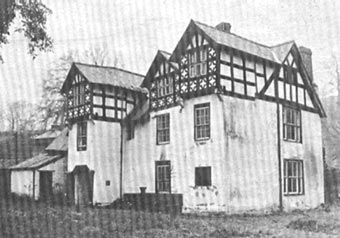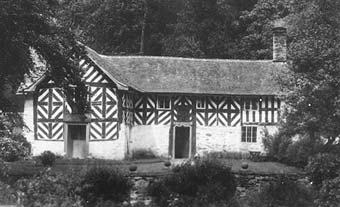Places
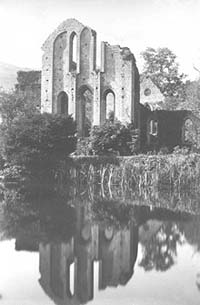 Valle
Crucis Abbey Valle
Crucis Abbey
Valle Crucis Abbey was founded in 1200. Madoc
ap Gruffydd gave the township of Llynegwestl to the monks
of Strata Marcella to build the Abbey. Because the Cistercians
preferred isolation the existing inhabitants were re-located
to Stansty and Northolt, 10 miles to the north east.
Valle Crucis is Latin for Valley of the Cross.
The name derives from the nearby Eliseg’s Pillar, which
was erected as a cross in the first half of the 9th century.
Valle Crucis Abbey prospered for 300 years,
but by the latter part of the 15th century the monasteries
were fast losing their commanding position in society. The
story of decline was a long one, but the final fall came suddenly
with Henry VIIIs dissolution of the monasteries. Valle Crucis
was one of the first to be suppressed in Wales, being dissolved
in 1536.
Having passed through several owners, the
Abbey was purchased by John Trevor of Trevor Hall around 1663.
It passed down the Trevor family to Mary, his great great
granddaughter. She converted the Chapter House into a dwelling.
From this time on the Abbey was rented out as a farm. Passed
down through the Lloyd family before being sold to Mr Lloyd
Jones of London in 1947, it passed into the care of the Ministry
of Works in 1951 and is now looked after by Cadw.
|
| top of page |
|
|
The hill on which the ruins
of Dinas Brân now stand was occupied in very early times.
Four bronze axe heads found on the slopes, and the earthworks
of a prehistoric hill fort around the ruins, point to ancient
occupation of this natural stronghold.
Different authors ascribe different
dates to the stone ruins that remain today. It seems most
likely, however, that the castle was built by Gruffydd ap
Madoc, Prince of Powys, sometime before his death in 1269.
The impressive stone fortress
had a very short active life. In 1277, Henry de Lacy, Earl
of Lincoln, lay siege to the castle and the Welsh, realising
their hopeless cause, set fire to Dinas Brân.
The ruins of Dinas Brân
have attracted tourists for over a century. At the end of
the 19th century, a ‘camera obscura’ was built
in the ruins to take advantage of the height of the hill and
the views it afforded. In the middle of the 20th century there
was even a shop on the summit, with the supplies carried up
by donkey.
|
|
top of page |
|
There are references to a bridge at Llangollen
as far back as 1284 but the first stone bridge was built by
John Trevor, the Bishop of St Asaph in 1345.
Rebuilding took place in 1656, and a stone
with this date and the name of the stone mason, Rondle Reade,
was found during a later bridge widening. The downstream side
of the bridge is unaltered since the 15th century but the
bridge has been widened twice on the upstream side.
In 1871 a census recorded 6585 people, 298
horses, 129 waggons, 92 carts and 79 cattle using this 8 foot
wide bridge – sufficient evidence of chaos to justify
the 1873 widening! In 1863 the symmetry of the arches had
been spoilt by the addition of the railway arch and, during
this work, pieces of tombstones with Latin inscriptions were
found, thought to have come from Valle Crucis Abbey. The widening
in 1968 was due to traffic congestion.
Llangollen’s bridge is regarded as
one of the ‘Seven Wonders of Wales’:
“Pistyll Rhyadr and Wrexham Steeple,
Snowdon’s Mountain without its people,
Overton yew trees, St Winefride’s Wells,
Llangollen Bridge and Gresford bells”.
|
| top of page |
|
|
Eleanor Butler and Sarah Ponsonby moved into
the small stone cottage of Pen y Maes in 1780, having run
away from their families in Ireland two years previously.
Re-naming it Plas Newydd (New Hall) they
made extensive improvements to the house and created new gardens.
The ‘Ladies of Llangollen’ finally purchased the
house in 1819 and went on to live there until their deaths
in 1829 and 1831.
Over the years they became known for their
eccentricity, preferring always to dress in dark riding habits,
and played host to many famous people, including the Duke
of Wellington, Sir Walter Scott and William Wordsworth.
After the death of the Ladies Plas Newydd
was purchased by another two spinsters, Amelia Lolley and
Charlotte Andrew, who attempted to emulate the Ladies’
lifestyle. In 1861 Plas Newydd was bought by Mrs Robina Couran
who owned it for 15 years before selling it to Richard Lloyd
Williams of Denbigh, who in turn sold it a few months later
to General John Yorke. General Yorke added the black and white
timbering, built a new west wing and opened the older rooms
to the public. On his death in 1890 Plas Newydd was sold by
auction and passed through a number of owners until it was
bought by Llangollen Urban District Council in 1933 who opened
it to the public.
In 1963 The Council demolished the east and
west wings, leaving Plas Newydd the same size as when occupied
by the Ladies. Today it is owned by Denbighshire County Council
and continues to be open to the public.
|
| top of page |
|
|
Thomas Pennant, in
his tour of 1773, refers to the House of Llantysilio as being
the seat of Thomas Jones and in 1750 and again in 1792 we
find that Thomas Jones of Llantysilio Hall was the Sheriff
of Denbighshire. Pennant says that the “previous possessors
were the Cupers or Cuppers – styled even so early as
the time of Henry II the ancient Cuppers of the north”.
Thomas Cupper purchased the estate and built
the original Hall at the beginning of the 18th century, and
his daughter and sole heiress conveyed it to the Jones family
by marriage with Thomas Jones, then of the county of Montgomery.
Thomas Jones’ son and grandson, both also called Thomas,
continued to own the estate, with the last Thomas Jones dying
in 1820 leaving no will. The Hall, a “large brick building”
passed to a Major Harrison who had proved his case to inherit
and spent the next seven years fighting challenges to his
claim.
In 1822 the housekeeper of the vicar of
Oswestry dreamt that the will of Thomas Jones had been buried
with him. Because of this dream a party of seven or eight
people, including a lawyer and a surgeon, broke into the tomb
and opened the coffin, although it would appear that the will
was not found.
In 1873, Charles Frederick Beyer, who had
purchased the Hall in 1867, constructed a new building of
Ashlar stone and, in 1875, demolished the old Hall. He left
the Hall to his godson, Sir Henry Beyer Robertson, and the
house remained in the Robertson family until the late 20th
century. During the Second World War Llantysilio Hall formed
the Junior School for Moreton Hall School, catering for girls
between the ages of 6 and 13.
|
| top of page |
|
|
Originally a small cottage called Braich
y Gwynt, in 1865 Bryntysilio was bought by Sir Theodore and
Lady Martin. The house was greatly enlarged, the work being
completed in 1870. In 1889, Queen Victoria, a good friend
of the Martins, took tea at Bryntysilio when she visited Llangollen.
Occupied by the military in the Second World
War the house was afterwards restored, but much reduced in
size by Mr Sydney Aston before being later sold to Walsall
Education Authority as an outdoor education centre.
|
|
|
The current Trevor Hall was built in 1743, but occupies a
much more ancient site which was the home of John Trevor,
builder of Llangollen Bridge. Constructed of brick, the
south front is a modernisation of the much earlier house,
built entirely of stone.
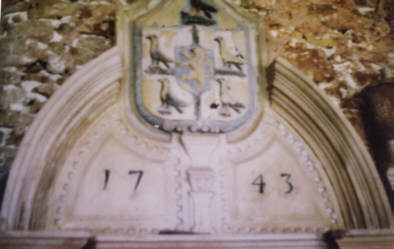
|
| top of page |
|
|
The first Chain Bridge was constructed in 1814 by Exuperius
Pickering in order to take his coal across the river for delivery
to Corwen and Bala.
In 1870 the bridge was re-built following damage by heavy
flooding. Further heavy flooding in 1928 piled up trees against
the bridge and the whole structure was washed away.
In 1929 Henry Robertson built the suspension bridge that
still remains.
|
|
|
Plas yn Pentre was a Grange belonging to Valle Crucis Abbey.
In a survey of 1291 it is described as:- The Grange near the
monastery, three ploughlands, mills and other conveniences.
On the dissolution of Valle Crucis Abbey in 1536 Plas yn
Pentre came into the possession of the High Sheriff of Denbighshire,
Ieuan Edwards. His grandson partially re-built the house in
1634 and his initials and the date can be seen carved into
the exterior of the west gable.
In 1834 the house was bought by the Reverend T. Whitwell
Rogers and it was during his ownership that some loose boards
in the floor disclosed three pieces of sculptured alabaster,
two of which fitted together. These two pieces show a scene
of the crucifixion and the other was described as ‘a
scene in the life of St Arthmael, a south Wales saint’.
It is thought that the alabaster scenes were taken by the
first Ieuan Edwards from the abbey after the dissolution.
|
| top of page |
|
|
There are many stories associated with Plas Uchaf (Highest
Hall), and much history. The oldest legend associated with
the house is that of Owain and Nest. Owain, Prince of Powys
at the beginning of the 12th century, became infatuated with
his cousin Nest, who was married to Gerald, steward of Pembroke
castle. Having heard of the beauty of Nest, Owain visited
her at Pembroke castle on the pretext of kinship. He returned,
however, the same night and set fire to the castle. Nest made
her husband escape through the privy hole, but she was captured
by Owain, along with her children, taken to Powys and hidden
at his hunting lodge at the site of Plas Uchaf. The kidnap
is reported in contemporary documents, but no mention of a
hunting lodge is made, simply that Owain returned to Powys.
Most of the manor is of Tudor and Elizabethan construction.
It is, however, possible that some parts of the house are
older, possibly dating back to the 14th century. There is
speculation that the site was occupied back in Roman times,
although the only evidence for this was the discovery of a
possible Roman floor tile in peat dug nearby. A later known
occupant of Plas Uchaf was Colonel John Jones, who’s
second marriage was to the sister of Oliver Cromwell. Until
about 1904 a picture of Oliver Cromwell hung in the hallway
at Plas Uchaf.
W. Watkin Davies recorded in 1930 that there was an inscription
over the door stating that “the manor was inherited
by the princes of Powys in 1073 from Bleddyn, King of Gwynedd”.
The inscription is not genuine, however as it was put there
by Thomas Jones of Plas Llanerchrugog who purchased the house
towards the end of the 19th century.
|
| top of page |
|
|
Dinbren Hall occupies a splendid
location half way up the hill. Indeed, it is possible that the
name Dinbren, referred to in some of the early records from
1626 as Tynbrin (Ty yn Bryn = House in/on a Hill), is derived
from the location of the manor of this estate. Another
possible source is that the name is compressed from Dinas and
Brān, coming from the nearby castle.
In the 17th
century, many of the properties in Dinbren were owned by the
Wynnstay Estate. Over the next 200 years a number of these
were acquired by Dinbren Hall and the estate grew. In the
latter half of the 18th century the estate was
owned by David Roberts, being sold to Richard Jones in the
1800s. Richard Jones was a man of independent means who lived
in the Hall with his wife Emma and three servants.
The present Hall, a two storey Georgian country house, has
a date of 1793 and was built on the site of an earlier house,
part of which was incorporated into the later building until
the house was reduced in size in the late 1950s.
|
|
|
Ty'n Dwr Hall was built in the 1860s by John Dickin on land
once belonging to the old Pengwern Hall estate. It has in the
grounds what is considered to be the largest yew tree in
Wales. The small cottage next to the Hall pre-dates it and was
visited by George Borrow in 1854, when he remarked upon the
nearby yew tree.
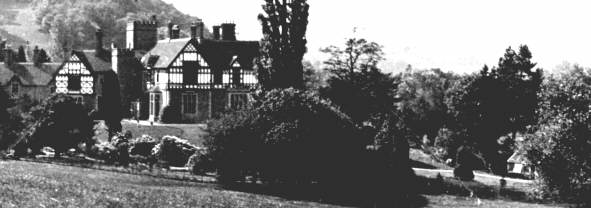
How long people have lived on the site of Ty'n Dwr is not
clear, but a well in the cellar of the hall is much older and
is said to date from Saxon times. Ty'n Dwr has for the last forty years
or so been a youth hostel owned by the YHA.
|
| top of page |
|
|
There has
been a house on the site of Plas yn Vivod since at least the
early 18th century and maybe before. Some re-building was done
in the early 1800s by the Ellerton family but the current
building mainly dates from the 1850s or early 1860s, with
considerable enlargement and remodelling in 1871 by W.J. Green
for William Wagstaff.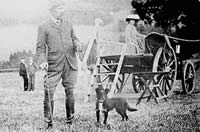
Further additions and alterations were made in 1906-10 by
R.T. Beckett for the Best family, who were descendants of the
Wagstaffs. The Best family continue to occupy Plas yn Vivid
today.
For many years Plas yn Vivod was home to the Vale of
Llangollen sheepdog trials (see photo), now moved to a new
venue at Llandyn.
|
| top of page |
|
|
|
 Valle
Crucis Abbey
Valle
Crucis Abbey 